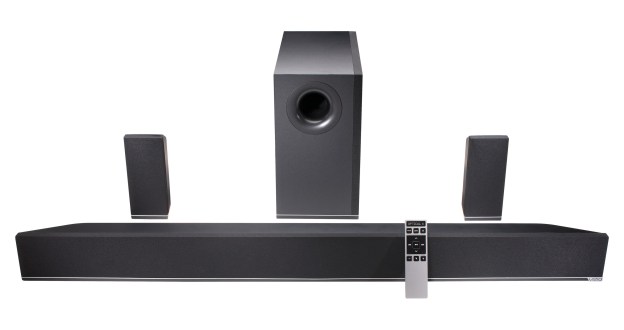
With bezels fast becoming a thing of the past, the habitat for built-in TV speakers is rapidly disappearing. As a result, external options like speaker systems and/or sound bars are now virtually essential for the audio-conscious television owner.
We saw quite a few innovative sound bars this week at CES 2013, and though Vizio’s new 42-inch S4251W sound bar – part of the 2013 line it showcased at the event – doesn’t exactly raise the bar on sound bars in general, it does exceed Vizio’s previous efforts by adding in enhanced connectivity (including Bluetooth), a wireless subwoofer, and a clever and convenient remote feature.
Via a built-in LCD display, Vizio’s proprietary Display Remote shows the sound bar’s status, eliminating the need to rely on the often tiny letters and numbers on its face. Those with larger TV rooms will no doubt find this a subtle-but-welcome improvement.
On the audio side of things, the bar itself houses two 2.5-inch drivers while a 6-inch driver is tucked away in the system’s wire. Add in the rear satellites and you’ve got plenty of boom, plus clear audio with an SNR of 102dB. This should prove a solid system, well-suited for filling small to average sized rooms.
This 42-inch model is part of Vizio’s 2013 Home Theater Sound Bar line which also includes 40-inch and 54-inch models, each of which corresponds to a different range of TV sizes. Aside from that, the principal differences are the sub sizes (8-inch for the 54-inch, 6-inch for the others) and power levels, with the 54-inch model also sporting a slightly larger cabinet to accommodate high-excursion drivers.
The S4251W is expected to retail for $330, which is a bargain based on what we heard at CES. No word yet on release date, though Vizio did indicate at CES that the bars should be coming available sometime this spring.
Editors' Recommendations
- Vizio brings new channels, features to its booming WatchFree+ streaming service
- Vizio’s entire 2021 TV line-up: Gaming-friendly models start at $250
- Vizio M-Series 5.1 soundbar shows up as a Costco exclusive for $300
- Vizio reinvents its soundbar line, including an Atmos bar with rotating speakers
- Vizio’s new TVs and soundbars go on sale today. Here’s where and for how much


